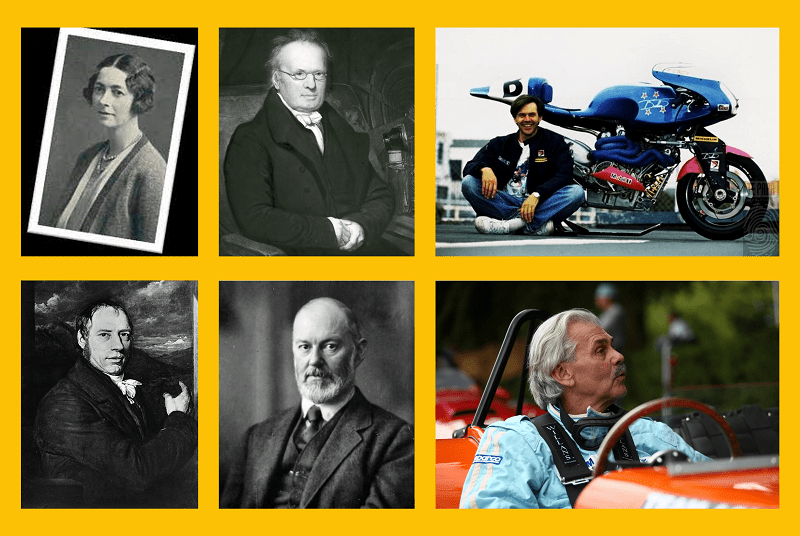Standing on the Shoulders of Giants
When it comes to engineers there’s a lot of inspirational people from history whose innovation and intellect have given us the tools to tackle today’s engineering challenges.
Some of the engineers respected and revered in the Bennett Engineering office come from different engineering disciplines to our area of expertise. That doesn’t take away our respect for their achievements OR mean there’s not things we haven’t learnt from them or even still use in our approaches today.
Here’s some of our favourites:
Verena Holmes
One of Loughborough University’s graduates was mechanical engineer Verena Holmes. Verena liked engines; all of them whether they were marine, locomotive, diesel, or combustion engines. She set up her own consultancy in 1925 and designed a range of things like a surgeon’s headlamp and a poppet valve for steam locomotives. In World War II she worked on naval weaponry, become an adviser to the government, and began the training of essential munition workers.
Her journey and achievements are very inspiring for engineers of today, may she encourage more women into one of the world’s best professions that is still needed today.
Richard Trevithick
Working in the Cornish mines in the late 1700s Richard Trevithick was an inventor and a mining engineer. He’s believed to be one of the earliest pioneers of steam powered road and rail transport and designer of a high pressured steam locomotive.
Richard took his mining expertise, gathered from the Cornish mines his father owned, to Peru and Costa Rica. There he continued to push the use of steam powered engines to help with mining activities to make them more efficient and safer to extract minerals. Impressive work to be doing in that era!
His first full sized steam locomotive for the road was called the puffing devil and carried it’s first set of passengers on it’s maiden journey in 1801 and in 1802 he patented his high-pressured steam engine. He is essentially the creator of the beautiful machines that are such a joy to see slowly moving along to arrive at a country fair today.
Marc Brunel
Marc was the engineer to who designed the Thames Tunnel; the first tunnel in Britain however that and fathering Isambard is not all he achieved.
He was a talented mechanical engineer who contributed much to the evolution of sawmill machinery; including the introduction of an easy to use block making machine which not only could be operated by unskilled workers it also gave an output of ten times more than ever seen before.
There were a multitude of problems encountered with the Thames Tunnel, something that many other engineers deemed an impossible feat. Marc Brunel, as the chief engineer, stuck by the requirement to have a substantial tunnelling shield despite the desire to have a cheaper alternative, which paid off. Understanding WHY that was the best option and getting everyone on board is still a challenge for engineers today.
Henry Royce
Everyone knows Mr Royce as part of the Rolls Royce dynamic who set up automotive and airplane engine manufacturing.
It’s the journey that Henry took that’s of most interest, starting an apprenticeship in railway engineering he then moved into tool making. This grounding then led him to setting up a dynamo and electric crane manufacturing company which transitioned to a motor car idea.
Fundamentally Mr Royce was a mechanical engineer and he had the desire to improve on what was already in existence. This is when Mr Rolls saw the motor car that was one of the two made and the rest is automotive history!
His motto “whatever is rightly done, however humble, is noble”, is something that still resonates for us today as mechanical engineers.
John Britten
John was a mechanical engineer whose legacy lives on today; he started his career designing off road equipment and heavy machinery in his home country of New Zealand. Moving over to the UK he worked on highway designs to link the M1 and M4 motorways.
He had a desire to develop innovative methods for using composite materials combined with high performance engines which led him to set up a motorcycle company. The Brittens motorbikes set astounding speed records and were built using those innovations he came up with to give a motorbike that is still revered today. Sadly there were only 10 Britten V1000s built before his death at the young age of 45.
Gordan Murray
Professor Gordan Murray is THE most successful engineer in the history of sports; specifically Formula 1 motorsports. His automotive career is just inspiring as not only did he design racing cars he also moved those to being mass made as road cars.
During his time in F1 he won more than 50 races but his quest for challenges, particularly tough ones led him into the world of manufacturing. It’s the innovative approach Murray has that he combines with his experience that has seen success. By understanding materials and load bearings he was able to identify a completely new way to build road cars.
Colin Chapman
The founder of Lotus cars Chapman used his aeronautical expertise to bring new technologies and advances to the world of sports cars. He started Lotus as a side hustle (in today’s terminology!) and he wanted to achieve light weight and brilliant handling.
As a structural engineer who then learnt to fly Colin Chapman bought a great deal of innovation to the automotive sector which lives on in Lotus cars today. During the 1950s he built racing cars which he revolutionised with small lightweight mid-engine vehicles that gave both power and superior handling. Showing that your passion for something can bring innovation to that thing to leave a legacy that’s a winner.


